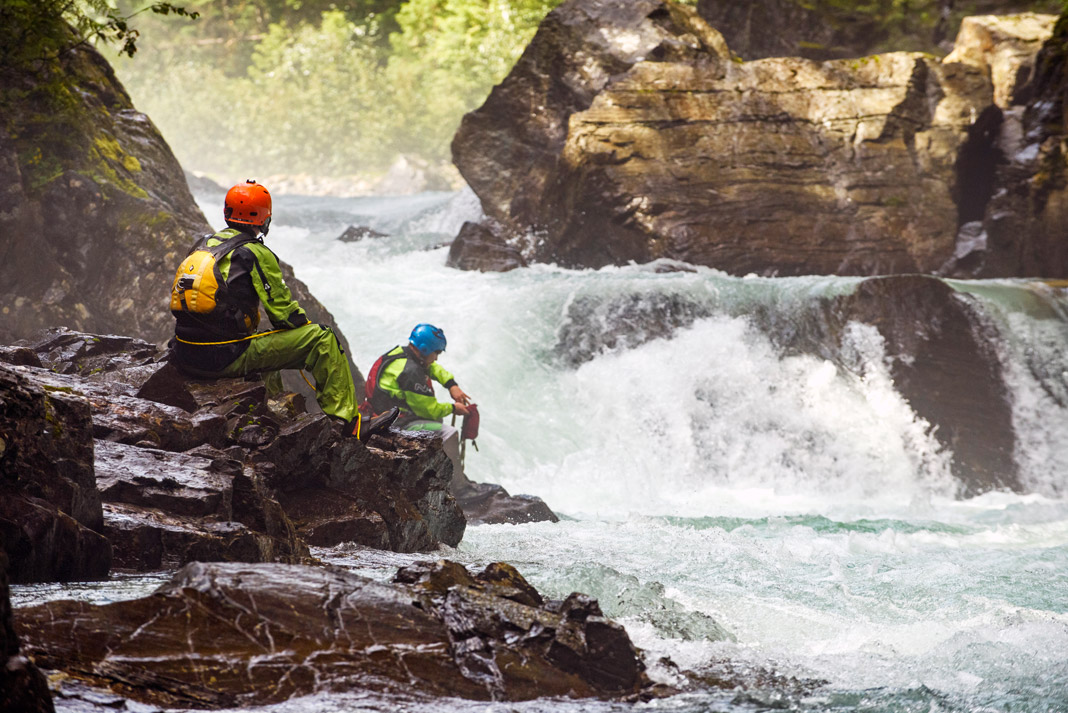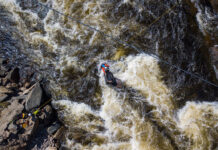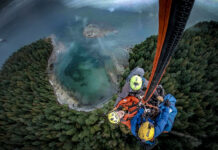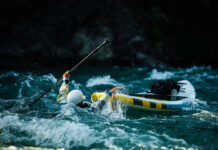I‘ve had my share of swims, as I’m sure you have too. Especially in the early days when my kayaking universe was expanding outwards. I was compelled—as perhaps you were, too—to climb the difficulty ladder to prove my abilities somehow (prove to whom?).
As a raft guide in the east, flipping and swimming is part of the game, but those tend to be pretty predictable and controlled, if such a thing can be said.
I’ve had long swims, cold swims, stuck-in-holes and bashing-rocks swims. One where I was left stranded clinging to a rock face and had to await my buddy’s lowered rope. One that left a bruise on my thigh that took five months to go away. But I’ve never had a desperate swim.
New research into the causes of whitewater drownings is attempting to understand flush drownings. In their research article, “Flush Drowning as a Cause of Whitewater Deaths,” two Colorado medical doctors looked at whitewater fatality data from the American Whitewater Association and attempted to parse out the significant variables. Plug the article title into Google Scholar to read the full text.

Flush drownings could be construed as mysterious, for these do not seem to have a direct cause. Whitewater folks would colloquially call a flush drowning a situation where a long swim results in death, with no apparent complications like head impact or strainers. The research authors focused on water temperature and geography, as their data set compared western river fatalities to those in the east. The authors concluded cold water plays a role in the likelihood of flush drowning.
An aside: As an academic researcher myself, there are rigorous protocols in examining data and making claims of absolute truth. For our niche whitewater activity, we have largely escaped academic interest, and as such, any new findings are going to seem pretty self-evident. However, the research literature has to build itself one block at a time, taking pains to prove what is already evident to the rest of us.
So, the research authors conclude there is a correlation between cold water and flush drownings, primarily due to the data showing far fewer flush drownings in the east. Perhaps this is because of water temperature—which is warmer in the east. But, I argue, this is more likely due to the continuous nature of western rivers.
Any swim is a long swim in the west. Every second in the water increases the chance of drowning. Longer swims equal more exposure to the risk of drowning, regardless of temperature. By contrast, the eastern rivers data showed a far higher proportion of entrapment fatalities. By these authors’ logic then, are entrapment fatalities correlated with warm water? The first research trap drilled into Ph.D. students is correlation is not causation. Cold water is correlated to flush drowning; warm water is correlated with entrapment. This says very little about what caused what.
In my guide role, I’ve had my share of chasing down long swims. The Tutshi near Whitehorse is one notable memory, where the paddler swam for more than a mile before finally getting him into an eddy, exhausted and puking up water.
Desperate.
Another was on the Yampa in Colorado with early summer flood levels and swimmers in the water for a mile.
But I’ve also hauled up desperate swimmers who were in the water for just seconds. One was a kid, no PFD, 10 years ago at a favorite play spot. He was playing along the shore with his buddies and fell in. After 15 long seconds, he resurfaced. I hauled him onto my bow and got him to shore, near drowned, dazed and terrified.
Flush drowning is drowning. We don’t need an overriding reason to drown. We don’t need to be hit on the head or stuffed under a rock. We only need to suck water into our lungs. It can happen to any of us, which is why we wear PFDs, which is still no guarantee.
Every second spent swimming in whitewater ups the odds of sucking in water, no doubt complicated by cold water slowing us down, high gradient and water speed keeping us from getting to shore. Or a crappy old PFD that does not really float anymore. This is all correlated, but the cause is sucking in water.
We need to continue to wrap our heads around the opposite of our collective experience. Swimming in whitewater exposes us to drowning, even though it does not happen very often.
Jeff Jackson is an outdoor education professor at Algonquin College and a risk management consultant.
This article was first published inPaddling Magazine Issue 62. Subscribe to Paddling Magazine’s print and digital editions here , or browse the archives here.
New study concludes cold water plays a role in the likelihood of flush drowning but it’s more complicated than that. | Photo: Daniel Stewart









Good article – brief but hits the nail on the head. One more point. The correlation between cold water and drowning is not entirely invalid. In my (mostly canoeing) experience when I flip into cold water I tend to gasp and am not able to get a good breath of air to hold. Being pushed downstream, going in and out of holes, waves, etc. makes it very difficult to acquire a good lungful of air to hold in order to time when I can inhale and when I need to hold my breath. In warmer water I will typically get a good breath of air and hold it until the next opportunity to safely release it and inhale again. Without being able to do this timing at some point I will be forced to attempt a deep breath when there is no safe opportunity and inhale/ingest water.
I would say that the “correlation between cold water and drowning” is not only valid, but very well established. The physiological response has been well-researched by environmental physiologists, and the mechanism has been explained in detail. The cold water connection is best understood when one recognizes that cold shock is synonymous with a complete loss of breathing control. One aspect of this is a greatly diminished ability to hold one’s breath.
I am neither a medical professional nor a researcher, but I am an avid whitewater paddler who has run many rivers in the southeast, southwest and Pac Northwest. Personally, I understand the argument about cold water influencing flush drownings. The second of impact with really cold water will take away your breath and cause you to involuntarily deep breath resulting in taking in substantial water if you happen to get hit by a breaking wave just as you hit the water. I know about this from Big Mallard on the Main Salmon in Idaho, and the water was not all that cold that late July day.
The sudden shock of cold can cause involuntary reactions in the autonomic nervous system, whether in air or water, that nobody can be trained to overcome. But, you can wear the appropriate attire, and that definitely means whatever number and thickness of base layers you wear under a drysuit, or even a wetsuit, to insulate your core from cold water exposure.
The truth is that nobody really knows the true facts about any drowning because the only person who does know is not talking. I am actually contemplating getting and carrying attached to my body, but out of the way, a SpareAir 3.0 or 6.0 liter SCBA system to make sure I have clean, fresh air to breath when I am under water because I have had a LONG swim underwater from which I was certain I would not come back alive. The water was not cold, but when I ran out of air I instinctively and involuntarily opened my mouth and gasped for air taking in water in the process before fighting my way to the surface. Regardless of arguments over how and why people drown just take every precaution to prevent swimming and be prepared when you do. If your number is up the rest does not matter anyway!
It’s possible to acclimate to cold water and either reduce or eliminate the cold shock response. We discuss that here: https://www.coldwatersafety.org/acclimation-to-cold-water. When being flushed through rapids, aerobic capacity matters – the key element being “How long can you hold your breath?” Also, we know a lot about drowning, and the phenomenon of sudden cold water drowning has been succinctly described for decades.
Swimming is a basic skill that is mandatory to have when participating in paddlesports. Knowing how to swim in whitewater is just as important as being able to paddle well.
Also, cardiac output is a measure of fitness that was not mentioned in the article. I would like to see an article written about what aspects of fitness serve to impact one’s ability to survive in cold water etc.
There is not enough written on the fitness traits that do serve to engender survival in cold water. These studies do exist.
The bottom line is that whitewater paddlesport is somewhat behind in reporting the human performance requirements to safely preform and excel in the sport.
It is possible to gain a great deal of technical expertise in paddle sports without having the fitness to manage in an adverse situation.
People spend time to prefect the ideal sport specific skill set without training the needed auxiliary fitness components to be able to manage in the varied environments where the rivers exist.
To most paddlers the fitness requirements for safe river travel are unknown.
This is in my mind what the deficit is. The reality is that paddling is not just a “recreational” endeavor like golf. Even the recreational user needs to have a base level of fitness to engage and even survive in the less than ideal environments that sometimes exist in nature.
I think you’ve also hit several nails on the head, Tracy. Have studies been done to check, initially, for correlation between general/cardiac fitness and drownings, or how long into the trip and drownings?
What about checking the blood oxygen levels of paddlers of varying fitness against time into the trip? Would this give any indication of how they would fare if they then had a swim?
Aerobic capacity is important. There are very real limits as to the type of research that you’re suggesting – these are both ethical and practical in nature. Also, research is both time consuming and expensive to conduct. Funding is finite, and the whitewater-related research that you suggest, while very interesting, would have a low probability of getting funded. You also can’t determine the aerobic capacity of a drowning victim. And since drownings occur in a variety of circumstances on wildly different rivers, standardization is going to be very elusive. What would be far easier to accomplish – and illuminating – is a study that compared flush drownings on cold rivers with wearing or not wearing thermal protection.
As the founder and director of the National Center for Cold Water Safety, I can speak with authority on the cold water connection. In this article Jeff correctly notes “Every second spent swimming in whitewater ups the odds of sucking in water”. However, the idea that cold water simply “slows us down” doesn’t begin to address the immediately life-threatening nature of an unprotected [no wetsuit or drysuit] cold water immersion.
To fully appreciate that danger, it’s necessary to understand two things: 1) Without thermal protection, most people will experience maximum-intensity cold shock when immersed in 50F – 60F (10 – 15C) water. 2) Cold shock is best understood as a complete loss of breathing control. It’s characterized by gasping, hyperventilation, and a greatly reduced ability to hold your breath. These are well-documented scientific facts. Loss of breathing control also causes swimming failure.
Now, imagine all these completely involuntary responses [you can’t control them] occurring as you’re being flushed through rapids, repeatedly submerged and overwashed by waves. It’s a combination that greatly increases the potential for inhaling water and suddenly drowning.
We discuss all of this in great detail on our website: http://www.coldwatersafety.org. The site has been live on the internet for almost 12 years. I believe it’s wise for anyone who plans on researching or writing about cold water safety to make sure that they’re very familiar with the information that’s available there.